All you need to know about the Palatine Hill of Rome: discover its significance and role in the history of Rome + tips for visiting this incredible Rome site.
The Palatine Hill is one of the seven hills of Rome and one of the most significant in the city’s history.
Colle Palatino, as the Palatine Hill is called in Italian or Platinum in Latin, is where Romulus founded Rome.
It is also the place the Emperors chose as their residence, to highlight their symbolic connection with Rome’s founder and, therefore, the legitimacy of their power.
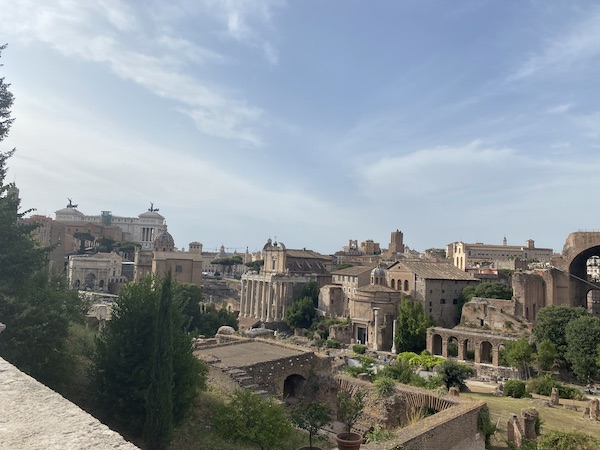
The Palatine Hill is above the Roman Forum and beside the Colosseum, in Rome City center.
The three attractions are not part of an archaeological area called ‘Parco Colosseo’ and you visit them with one combined ticket.
This guide will look at the most important things you need to know about the Palatine Hill, the main things to see while visiting and the best tours and tickets of the Palatine Hill.
I will also share some practical tips for visiting, covering essential points such as what to wear, the best time to go and tips for visiting with kids.
Please note: this post contains affiliate links and, should you make a purchase through them, we might make a small commission.
Where is the Palatine Hill / Colle Palatino in Rome
The Palatine Hill is in Rome City center.
The Hill is located close to Capitoline Hill, Aventine Hill, Coelian Hill and Oppian Hill, in Rome City centre.
Nearby, there are the Colosseum, the Roman Forum, the Circus Maximus, the Aventine Hill and the River Tiber.
Top tip! You can catch some of the best views of the Colosseum from the climb up to the Palatine!
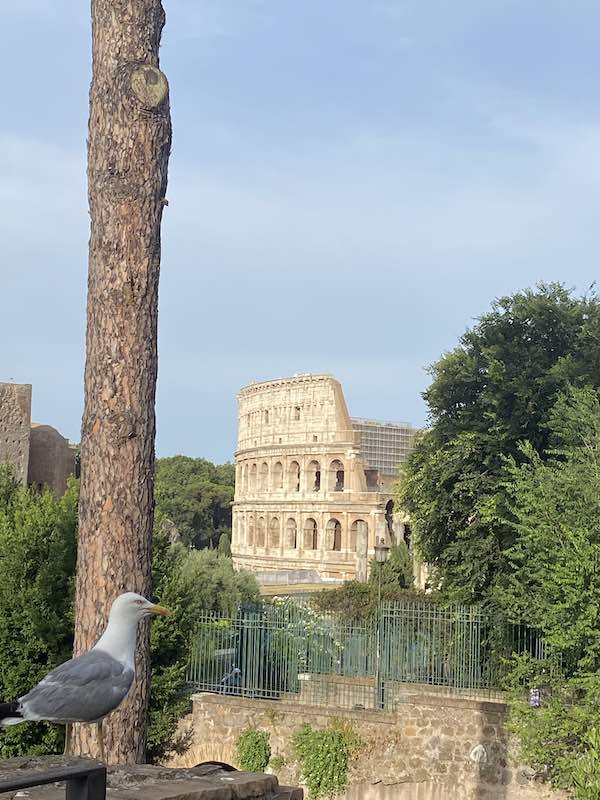
Close to it you also find the arch of Constantine, Piazza Venezia and Via dei Fori Imperiali.
The central position of the Palatine Hill is quickly explained. The Palatine is where Rome was founded so all the most ancient Roman ruins are in this area.
While Rome expanded well beyond the Palatine Hill, this remained the center of the city and it is therefore where you find the highest concentrations of ancient Roman ruins.
How to get to the Palatine Hill
The closest metro stops to reach the Palatine Hill are Metro Colosseo and Metro Circo Massimo, both only a couple of minutes on foot from the entrance to the Palatine.
Buses serving this area are: 51, 75, 81, 85, 87, 118 and tram n.3
Currently, access to the Palatine Hill is from Via Sacra, which is also the main access to the Roman Forum Area.
As you walk in, you pass security and ticket checks and you find yourself on a trail slowly climbing to your left to the top of the Palatine.
Clear directions lead you to the top and you can choose between steps or an easy trail up.
While the walk up doesn’t require much effort, the walk is uphill and you are outdoors so I recommend you come here ready to walk: comfortable shoes and clothing suitable for the weather are a must (see below: what to wear to visit the Palatine Hill).
Why is the Palatine Hill famous?
The Palatine Hill in Rome is famous for being where Romulus founded the city and where Roman Emperors had their imperial palaces.
Most likely, the Palatine hill was chosen as the place for the foundation of Rome because of its height and strategic position over the River Tiber.
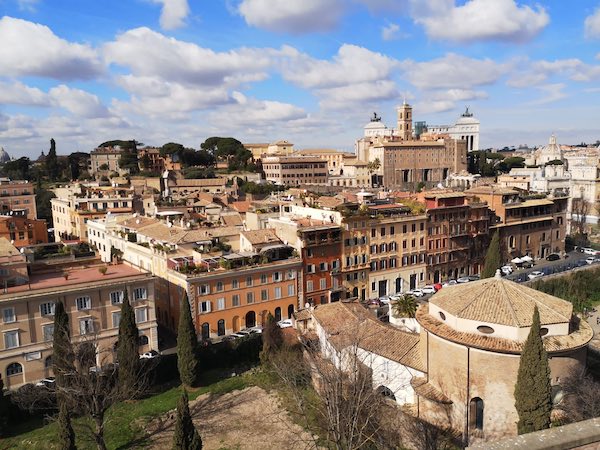
Roman legends also tell us that the hill was selected after a good omen appeared to Romulus: you can read here >>all about the legend about the birth of Rome
Later, the Palatine was used as a residential area for the most prosperous families of Rome and, in Imperial time, became the location of choice for the residence of the Emperors.
The Palatine is also famous for being one of the most beautiful spots in Rome and for its stunning panoramic terraces, offering some of the best views over Rome.
How to visit the Palatine Hill in Rome
Access to the Palatine Hill is not free but require tickets that can be bough in advance or on site. I recommend you plan at least a couple of hours to see the Palatine, and additional time for the Forum below.

For ticketing purposes, the attractions on the Palatine hill are divided into two categories:
- Those you can visit with standard admission tickets
- The so called super-sites, find a list of Palatine Hill super site below
Is the Super Site ticket for the Palatine worth it?
Whether to see the supersites or stick with the standard admissions depends on your interests and time available.
The standard admission will allow you to see the overall layout of the Palatine Hill and the Imperial, palace, the outside of all the buildings and to catch fantastic views over Rome. All the photos in this post are taken during a visit with standard ticket.
If you have a special interest in history and architecture, then a visit to the Super sites is best as it will allow you understand better elements of construction and decorative elements you may otherwise miss.
To help you make a decision, I have included a description of both standard and super sites below.
List of Palatine Hill Super-Sites
The so called ‘super-sites’ on the Palatine Hill are (see details of each below):
- House of Augustus,
- House of Livia
- Aula Isiaca and Loggia Mattei
- Domus Transitoria
- Palatine Museum
- Neronian cryptoporticus
- Santa Maria Antiqua, with the Oratory of the Forty Martyrs, Temple of Romulus
The best tickets for the Palatine Hill
There are several ways to visit the Palatine Hill:
Standard Entry ticket by Coopculture, including Colosseum and Roman Forum.
This is the cheapest type of ticket available as the Colosseum official concession sells it, cutting out the middleman.
It includes a guided tour of the Colosseum and access to the Forum and Palatine Hill, which you can visit on your own on the same day as the Colosseum or the day after.
It come with pros and cons:
The pros are good price and excellent quality of the guides in the Colosseum: I have taken several guided tours with Coopculture and I have always found them excellent.
I am a Roman history graduate from Rome so when I praise a guide, I never do it lightly! They are genuinely very good.
The cons of this ticket are the lack of flexibility and the fact that you only get a guide to the Colosseum, not the Palatine.
Coopculture ticket with Super Sites admission: the same as the ticket above but with additional access rights to ‘super sites’
Colosseum, Roman Forum and Palatine Hill entry ticket by Get Your Guide: a good alternative to the Coopculture Tickets mentioned above, with better cancellation options (check the small print on the booking page before purchasing)
Colosseum Forum and Palatine Hill Tour by Civitatis: 3 hour guided tour perfect for a more educational experience or if you are short on time and only have one morning to devote to Ancient Rome.
Colosseum, Forum and Palatine Hilll Tour for kids: designed specifically with the interests and needs of families with kids in mind

Is the Palatine Hill worth visiting?
YES.
The Palatine Hill is worth visiting and I am not just saying this because I am a Roman history graduate with a passion for Rome.
I recommend visiting the Palatine because it is one of the most beautiful photo spots in Rome as well as one of the most important landmarks in the city.
What to see on the Palatine Hill
The Farnese Gardens (Horti Farnesiani)
The Farnese Gardens are likely to be the first thing you see on the Palatine Hill.
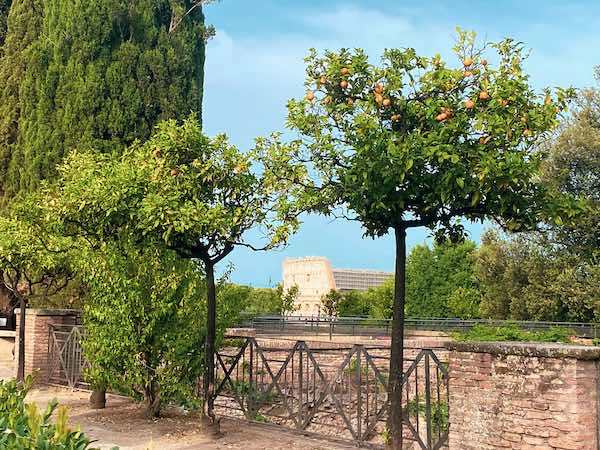
They are stunning, monumental gardens that develop on the top of the Palatine Hill and overlook the Forum and you climb up their monumental staircase when going from the bottom of the valley to the top of the hill.
The Farnese Gardens were built in the 1500s.
Since 1537, the Farnese Family acquired this area of the Palatine, which was a mix of ancient ruins, vineyards and agricultural land and gave order to transform this space into an area for rest and pleasure.
They reduced the amount of space for vineyards and orchards, and added monumental features, fountains and plants.
Quickly, the gardens gained fame for the rarity and variety of their vegetation but the panoramic position of the gardens also caught the attention of contemporaries, and of all generations ever since.
To make the most of the views over the Forum and the Circus Maximus, the Farnese ordered the creation of terraces, a ‘Casina del belvedere’ viewing area, a bastion overlooking Velabro and the Nympheum of the Mirrors, on the east side of the garden.
In the XVII century, Odoardo Duke of Parma added further embellishments and two large aviaries at the two sides of the terrace.
In the XVIII century, excavation started and more remains of ancient Rome’s imperial palaces came to light.
This new interest in ancient history and archaeology meant large areas of the gardens turned into an archaeological dig.
What we see of the gardens today is a small version of what the gardens would have been like: the architect who gave the current appearance is Giacomo Boni, a prominent scholar and archaeologist now burie in these gardens.
Climbing up the Palatine Hill via the monumental staircase of the Farnese Gardens is a pleasure.
The staircase itself is decorated with stunning fountains, water games and statues and the views over the Forum are breathtaking.
The huts of Romulus
The huts of Romulus are in the area of the Palatine called the Germalus, on the hill’s southwestern corner.

This group of dwellings was first identified in 1907 as an ancient settlement inhabited since the IX century and it therefore precedes the arrival of Romulus to this area, which ancient sources date to 753 BC.
According to archaeologists working in this area, this settlement would have been inhabited by dwellers who raised sheep, goats, dogs and donkeys and worked the land for crops of spelt, barley and wheat.
The best preserved hut here is usually called ‘the House of Romulus’: it has a rectangular plan, round corners and seven holes along its perimeter, which suggest the presence of a gabled roof with thatched with marsh reeds.
This hut shows signs of repeated renovations carried out over the course of the centuries and it is mentioned by ancient historians such as Dyonisus of Alicarnassus.
This seems to confirm the idea that this hut in particular had symbolic meaning already in classical times.
The House of Romulus is at the top of the Palatine but you also find a replica in the Palatine Museum, which is very useful to visualise how the structure would have looked.
The Temple of Victory
The Temple of Vuctory (Temple to Virgo Victoria) is an ancient temples on the slope of the Palatine, on Clivo Victoriae.
The temple seems to have been dedicated in 294 BC by Consul Lucius Postumius Magellus and seems to have been part of the same cluster of temples as the Temple of Magna Mater, beside it.
Nowadays, we only see the remains of the base of the temple however, the temple returned beautiful artefacts such statues of female goddesses and colorful pottery, now housed in the Palatine Museum.
The Temple of Magna Mater
The Temple of Magna Mater dates back to 204 and was built by order of the Senate.
According to ancient historians, at that time Rome was under the threat of the Chartaginean army led by Hannibal: to gain divine protection, the Senate order the building of a new temple, to be houses beside the one to Victory, on the Palatine.
The temple was dedicated to Magna Mater, a powerful female deity originally from Asia Minor.
According to Roman legends, Magna Mother Cybeles would have protected Aeneas on his escape from Try to Italy.
Since Aeneas was an ancestor of Romulus, a renewed connection with a city favorable to him seemed a good omen for the fortunes of Rome.
The temple rose beside that of Victory and that to Juno Sopita, forming an important cluster of temples to female deities in one of the most symbolically important areas of Rome
The Domus Augustana – The House of Augustus and the Palace of Emperors
In terms of visual effect, the most impressive sight on the Palatine Hill is the Palace of Emperor.
At the end of the Republican Age, in the I century BC, the Palatine houses the residence of all Rome’s most prominent families.
Fun fact! The English word ‘palace’ comes from here! Platinum > Palatium > Palace. Its etymology holds the memory of the use of Palatine as a residence for the wealthier Roman families.
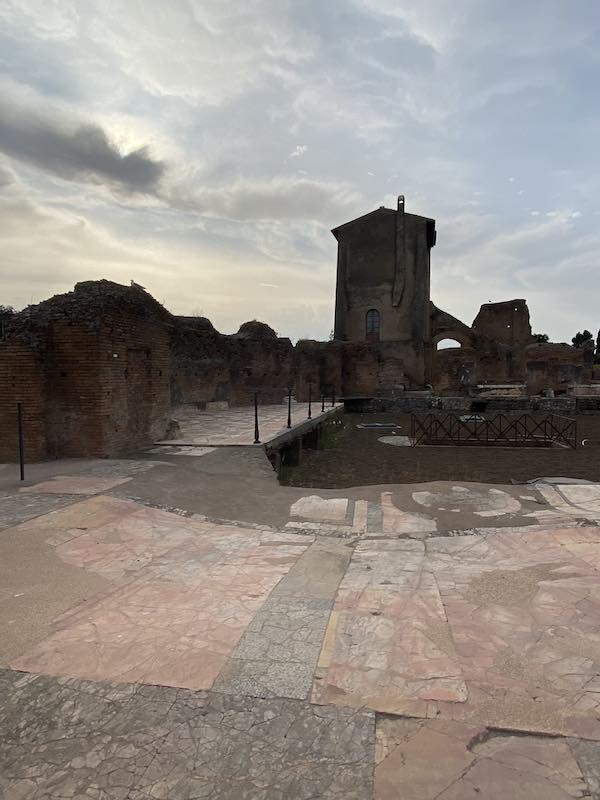
When Augustus took power, he also chose this area to build is Roman home: as well as putting him at the center of a beautiful area of the city, he knew living on the Palatine has strong symboling meaning.
Like a new Romulus, Augustus wanted to be seen as a the founder of a new era for Rome, an era of Peace and Prosperity.
Putting the House of Augustus in the same location as the House of Romulus was the symbolic gesture he needed.
A first imperial palace was built under Augustus; this building inlcuded a temple to Apollo, porticoes, Greek and Latin Librarues and meeting rooms.
The Domus Augustana as we can see it now however dates to the century AD and was built by Rabirius, architect of Emperor Domitian.
The Domus is divided into three parts: the Domus Flavia, with the rooms for business and entertaining guests, the Domus Augustana, the actual house of the Emperors, and the Stadium or Hippodrome, the palace garden.
The whole are stands out for the beautify of its marble decorations and statues and became what it is still nowadays referred to as ‘The Palace of Emperors’,
The Palace is stunning to see: if you have time, I highly recommend you go to the Circus Maximus after your visit.
It is just below the Palace, outside the archaeological park, but it offers outstanding views of the palace for the outside, the perfect complement to the sight you get from the Palatine.

Aula Isiaca and Loggia Mattei
Aula Isiaca is a vaulted chamber inside the Domus Augustana with beautiful decorations dedicated to the Goddess Isis.
The cult of Isis arrived in Rome in the first century AD and gained huge popularity, adding the Goddess firmly into the list of the most famous Roman Gods.
Inside the Domus Augustana is also possible to admire Loggia Mattei. Unlike the ancient Aula Isiaca, this loggia dates to renaissance times however, it is decorated with ‘grottesche’, a pictorial style that took inspiration from roman painting of the I century and in particular by those found in the Domus Aurea.
These two sites are among the so called super-sites and are only accessible with special tickets.
Domus Transitoria
Domus Transitoria (lit Transition House) was the temporary residence of Emperor Nero while he was waiting for his Domus Aura to be completed.
The Domus, while temporary, was as grand as the ego of the Emperor who lived there. Still nowadays we can admire its nymphaeum, waterworks, large chambers and columns.

La Casa di Livia – the House of Livia
The house of Livia is an ancient Roman house on top of the Palatine Hill believed to be the house of Livia Iulia Augusta, wife to Emperor Augustus.
The house is beautiful: in origin, the house would have had beautiful floor mosaics and frescoes and while many of them are now houses away from this building, in the museum at Palazzo Massimo, it ispossible to admire the hose of Licia as is used to be thannks to multimedia reconstructions that project on the walls the deocartions as they used to be.
The House of Livia is one of the so called super-sites and required additional tickets for you to visit.
The Palatine Museum
The Palatine Museum stands at the top of the Palatine Hill and hosts a collection of artefacts that spans over fifteen centuries of history of Rome, from its foundation to the highest successes of the Roman Empire.
A must-see for history lovers.
Criptoportico Neroniano
Nero’s Criptoportico is an undergound corridor originally part of the Domus TIberiana, part of hte imperial palace.
The corridor is illuminated by small windows and stands out for its mosaics and a beautiful ceiling. The Criptoportico is one of the so called ‘super site’ which require an additional ticket. The original of the cdelieng from this corridor can be seen in the Palatine Museum, the one in the current passage being a copy.
Santa Maria Antiqua
The church of Santa Maria Antiqua is on the slopes of the Palatine and is a treasure trove for art lovers.
The church hosts stunning paintings from the 6th to 9th century. The most famous and best preserved are those forming cycle of the martyrdom of St. Cyricus and St. Julitta.
The Oratory of the Forty Martyrs takes its name from the painting decorating its apse, dating back to the VIII century. This space was probably in origin the entrance hall to the Ramp of Domitian and the Imperial palace and then changed its role with the Christianisation of the Empire
Schola Praeconum
The ‘school praeconum’ is on the southern slope of the Palatine and dates to the III century AD.
The praeconed in Rome were the ancient heralds and this space was used to host their corporation. Still visible today are its beautiful mosaics, they seem to date from the IV century, probably made during the empire of Maxentius.
Beside the schola, we can also see remains of a different space, the Pedagogium, which would have hosted the training area for imperial slaves.
Visiting the Palatine Hill with kids
I visit the Palatine Hill with my kids often and they always enjoy it.

In the eyes of small kids, the Palatine is basically a large, beautiful park and while there are no games for them and you need to pay attention to where they go, for safety, the large spaces, fountains and flowery trees are easy for kids to enjoy.
Older kids are likely to enjoy the idea of being where the Emperors used to live and the Hut of Romulus is a rather exciting place as you literally stand where Rome was first founded!
My top tips for visiting the palatine with kids are:
Dress them appropriately: outdoor clothing and comfortable walking shoes are a must
Wrap them up well in winter: the Palatine Hill gets surprisingly cold
Bring a carrier if you have a baby: this will make the whole visit much easier than pushing a stroller on uneven terrain however, please be aware that there is a lot of walking to be done here so a very light stroller you can easily fold and carry may also come in handy.
Download the Y&Co app: this is a free app with info about the Palatine and the Forum and it has a kids’ itinerary I found excellent
Bring snacks: you cannot have a picnic on Palatine Hill but there is no problem having a rice cake or a small snack for a hungry toddler. There are no cafes here so make sure you bring your own
Drinking water and restrooms are available beside the Palatine Museum.
Consider a specialised family tour of the archaeological area such as this one.
See also: how to visit the Colosseum with kids.
What to wear to visit the Palatine Hill
There is no dress code to access the Palatine Hill.
The main things you need for your visit are good walking shoes, sun protection if visiting in summer and warm clothing for winter.
Need to know: if you are visiting on the same day as the Colosseum, leave bully bags at home as they will not be allowed into the Amphitheater.
I hope you enjoyed this guide to the Palatine Hill and it helped you plan your visit. Safe travels!
